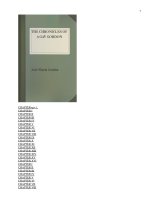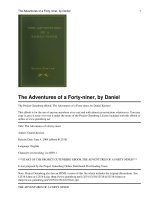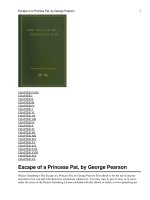Manufacture of a fast neutron detector using EJ-301 liquid scintillator
Bạn đang xem bản rút gọn của tài liệu. Xem và tải ngay bản đầy đủ của tài liệu tại đây (486.06 KB, 6 trang )
SCIENCE AND TECHNOLOGY DEVELOPMENT JOURNALNATURAL SCIENCES, VOL 2, ISSUE 2, 2018
76
Manufacture of a fast neutron detector
using EJ-301 liquid scintillator
Phan Van Chuan, Nguyen Duc Hoa, Nguyen Xuan Hai, Nguyen Duy Tan
Abstract—A fast neutron detector using the EJ301 scintillator was manufactured for study on
detecting fast neutrons and gamma-rays. Detector
characteristics include the energy linearity, the
efficiency response and the neutron/gamma
discrimination were guaranteed for neutron
detection in the energy range from 50 to 3000
keVee.
The
ability
discrimination
of
neutrons/gamma-rays of the detector was evaluated
by the charge comparison (CC) method using an
252
Cf source. The total efficiencies when measured
on 22Na, 137Cs, 60Co and 252Cf sources were obtained
17.8%, 3.9%, 9.8% and 14.8%, respectively. The
Figure of Merit (FoM) values of CC method were
0.4–1.55 for the range of energy 50–1000 keVee
(keV electron equivalent).
Keywords—EJ-301 liquid scintillator,
neutron detector, pulse shape discrimination
fast
1 INTRODUCTION
N
eutron detection is very important in
research about the field of neutron, such as
radiation safety, research material, scattering
particles, particle physics, etc. The slow neutrons
are commonly detected based on the nuclear
reaction mechanism, while the fast-neutrons are
detected based on elastic scattering mechanism
with light nuclei such as hydrogenous, 4He or
organic scintillators [1, 2]. Organic scintillator
detectors are widely employed in studies with fast
neutrons and gamma-rays by many good
properties: the fast decay time, the relatively high
light-output and a reasonably good efficiency for
fast neutrons [1, 3]. EJ-301 organic scintillator
was manufactured by ElJen Technology (or its
equivalent, NE213, BC501A), the yield curve
consists of two exponential decays – the fast and
Received: 13-9-2017; Accepted: 13-10-2017; Published:
30-8-2018
Phan Van Chuan1*, Nguyen Duc Hoa1, Nguyen Xuan
Hai 2, Nguyen Duy Tan 1 – 1Dalat University; 2Dalat Nuclear
Research Institute
*Email:
slow components of the scintillator light that
depends on different kinds of radiation [1, 4, 5].
By coupling a photo multiplier tube (PMT) – to
the scintillator, the light can be collected and
converted into a voltage pulse, allowing for data
acquisition/processing [1, 6]. Those properties are
commonly used to identify neutrons and gammarays by using pulse shape discrimination (PSD)
techniques.
Many PSD algorithms have been evaluated and
reported, such as zero-crossing (ZC) [6-8], PGA
[9], CC [6-8, 9-11], frequency gradient analysis
(FGA) [5], TCT [12], discrete Fourier transform
(DFT) [13], CPR [14], etc. Among them, the CC
and ZC algorithms are commonly implemented,
therefore they have become the industrial
standards which are used to compare with new
discrimination algorithms [5, 6].
In the present study, a fast neutron detector was
designed and manufactured using the EJ-301
liquid scintillator for neutron monitoring and
training purposes. A preamplifier was also
manufactured in order to make the suitable
shaping pulse for data acquisition and processing.
The qualities of the detector were assessed by the
total efficiency, sensitivity and linearity with
gamma-rays. The ability to distinguish between
neutrons and gamma-rays was assessed through
digital CC method. The CC method was
implemented by a program in MATLAB software
using the data that are digitized from the pulses of
detector by a digital oscilloscope.
2 MATERIALS AND METHODS
Detector manufacture
The designed layout of the detector is shown in
Fig.1, which consist of a liquid scintillator
container (cell), a photo-multiplier tube (PMT), a
voltage divider, a shield cover and a preamplifier.
The cell is a right cylinder made of aluminum
with 34mm diameter 60mm length in size. The
T P CHÍ PHÁT TRI N KHOA H C & CÔNG NGH :
CHUYÊN SAN KHOA H C T NHIÊN, T P 2, S 2, 2018
inner surface of the cell was polished and matched
PMT through ultra violet glass window with 2
mm thickness. The PMT Hamamatsu R9420 has
1.6 ns and 550 ps rise time and transit time spread
(FWHM), respectively [15]. The cell, PMT and
preamplifier are housed inside the cover shield
which is made of aluminum in the form of
cylindrical, with 49mm in diameter 200mm in
length. This cover prevents light from outside and
magnetic interference. The high voltage, signal
and power supply connectors are mounted at the
tail of the detector.
HV
Connector
Cell EJ301
Photomultiplier tubes
Hamamatsu R9420
Preamplifier
BNC signal
Power connector
Fig. 1. Layout of neutron detector
The signals produced by the PMT have a very
short rise time (less than 5 ns) because the fast
decays component of EJ-301 is 3.2 ns [4], so that
the signal is distorted when it is transmitted to
the digitized block, which is usually placed away
from the detector [1]. The preamplifier consists
of four main stages because the anode pulses
produced by the PMT are current pulses, the first
stage converts the current pulses to the voltage
pulses using the load resistance 50Ohms. The
second stage amplifies the signal voltage from
the first stage (gain of 30 times). The third stage
is a filter using the second-order low-pass Sallenkey filter (f-3dB=33.8MHz, Butterworth=0.6). The
final stage has matched impedance to match
cable impedance 50 Ohms. The Preamp would
shape the pulses which had the rise time of
approximately 12 ns and fall time of
approximately 31 ns for the pulse of gammarays. The total amplifier voltage gain of the
Preamp is -17.85 V/V and the output amplitude
at the Compton edge of the 137Cs source is
344.7mV and the 60Co source is 806.8mV,
respectively. The total noise of preamplifier
contribution to signal was 797.9±0.34µV, which
is equivalent to 1.13keVee calculated a
calibration energy scale of the detector.
Examined main characteristics of neutron
detector
The preamplifier was designed for linear
output voltages in the 0 to + 2.2V range,
corresponds to range from 0 to 3100keVee. A
77
test setup is shown in Fig. 2 which the
Preamplifier was tested in unconnected mode to
PMT. The input of the Preamplifier was
provided pulses from pulse generator (ORTEC
Model 419), which was installed the rise time of
5 ns and fall time of 20 us. The amplitude and
noise of both input and output pulses of the
Preamplifier were measured by two channels of
the digital Textronix Model DPO7254C
(DPO7254C) that was installed in at 1 Giga
samples per second (GSPS) and 2.5GHz
bandwidth. For each input pulse amplitude,
input/output amplitude values and the standard
deviation s In / s Out of the pulses were measured
by the DPO7254C. The amplitude of the input
pulse was adjusted from 2.8 to 417mV by
manual with 55 steps examined. The noise
generated by preamplifier was calculated by the
equation (1) [16].
2
- s In2
s Pr e = s Out
(1)
The results of the signal-to-noise ratio
(SNR), the gains, sensitivity and linearity of
preamplifier were shown in Table 1 and Fig.3.
Pulse
generator
ORTEC 419
Capacitor
box
Capacitor
box
In1 Oscilloscope
DPO7254C
In2
Fig. 2. The conguration of linearity, gain, noise and
sensitivity evaluation for preamplifier
Table 1. The preamplifier parameters
Parameters
Values
Measuring range
0 ¸ 3000keVee
Total noise
797.9 ± 0.34 mV
Baseline
35.8 ± 0.288mV
Sensitivity
707mV / MeV
Fig. 3. The output versus input amplitude of preamplifier
SCIENCE AND TECHNOLOGY DEVELOPMENT JOURNALNATURAL SCIENCES, VOL 2, ISSUE 2, 2018
ö
÷
÷
÷
÷
ø
Where, E c, E , me and c are maximum
backscatter energy, the energy of gamma-ray,
electron rest mass, and speed of light in
vacuum, respectively.
Table 2. Gamma energies from different nuclides
corresponding
to
their
calculated
energies
of
Compton edge as a function of experimental channels
measured by the MCA
Sources
Eg ( MeV )
Ec ( MeV )
Cs-137
Co-60
0.662
1.332
0.511
1.27
0.477
1.12
0.341
1.06
Na-22
100cm
(2)
The channel
number
107
141
330
313
Fig. 4. Pulse height distribution from sources of 60Co, 22Na
and 137Cs. The upper inset shows the calibration data using
the Compton edges of the gamma-ray spectra
The Table 2 showed that measurements were
performed with gamma-ray sources of 22Na,
137
Cs and 60Co, and each the measurement of
those gamma sources were placed beside the
monitor scintillation. Each the measurement of
the pulse amplitude histogram was measured by
Paraffin
Multi channel
analysis (MCA)
Neutrons / gamma-rays
Neutron source
252Cf
PMT
æ
ç
1
Ec = Eg ç 1 2 Eg
ç
ç 1 + m c2
e
è
EJ301
Because the light intensity of the EJ-301
liquid scintillator is good linearity on gamma
sources [1, 4], this study uses three 22Na, 137Cs
and 60Co standard sources to evaluate the
linearity of the detector. The relation the height
of pulse with energy at the Compton edge of the
gamma sources was used that evaluate the
linearity of the detector with energy. The
maximum backscatter energy (Ec) was counted
by equation (2) [1].
the DPO7254C as the amplitude spectrum of the
gamma source, respectively. The number of
channels of the Compton edge corresponded to
the Ec of the gamma source, respectively.
Because the Compton edge of the 1137.2keV
peak of 60Co was obscured by the that of
1332keV peak, only the Conton edge of the
1137.2keV peak was not used in the calibration.
The energy spectra of 60Co, 22Na and 137Cs
sources are shown in Fig. 4,that used the
oscilloscope DPO7254C which was operated in
spectrum mode.
H.V.
Digital oscilloscope
Preamp
78
Fig. 5. Schematic view of assessing total efficiency and data
acquisition system for EJ-301 detector
The total efficiency of the detector was evaluated
by the schematic on Fig. 5. The total efficiency is
defined as the ratio of the total number of events
which are detected to the total number of gammaray incident on the detector. The total efficiencies
of the detector were identified by 22Na (activity on
12/2000 was 9µC i), 137Cs (activity in 12/2001 was
11µCi), 60Co (activity in 12/2000 was 11µCi), and
252
Cf (activity in 05/2011 was 11.6mC i) sources.
The gamma sources are placed near the cell
scintillator and placed 100cm from the 252Cf
source to the detector (see Fig. 5). The pulses in
these processes include gamma source, 252Cf and
background were counted by the Multi-ChannelAnalyzer (MCA) and spectrum analyzer software
on a computer. The cross section of the liquid
scintillator cell when decrease 5% by the air
bubble was 19.4cm2.
Examined the
discrimination
ability
of
neutron-gamma
In order to assess the ability to discriminate of
the detector, this study used the 252Cf source,
which was placed at 100cm from the detector
(Fig. 5). The detector was biased high voltage of -
T P CHÍ PHÁT TRI N KHOA H C & CÔNG NGH :
CHUYÊN SAN KHOA H C T NHIÊN, T P 2, S 2, 2018
1200 V by the High Power Supply (Canberra
3002D); the detector’s pulses were acquired by
the DPO7254C which was set at 12bit resolution,
the bandwidth of 2.5GHz and at a sampling rate
of 1 GSPS. The pulses were transferred to the PC
for offline analysis by the PSD CC method. The
program of PSD CC method was performed on
MATLAB software and the results of the graph
and FoMs were calculated by the Originlab 8.5
software.
Fig. 6. Typical neutron and gamma-ray pulses in one sampling
The typical neutron and gamma – ray pulses
with the same amplitude of the EJ-301 detector
were shown in Fig. 6. The neutron pulses
exhibited a larger decay time to the baseline, so
with the same amplitude neutron/gamma pulses
the area of the tail of the neutron pulse was
greater than that of the gamma pulse. The digital
PSD method chosen for comparison consists of
integration techniques were applied to digitized
79
pulses, where each pulse was integrated twice,
using two different ranges [7-10, 14]. The total
integral was calculated for full pulse that began is
at the start point (t1) to an optimal point at the tail
pulse (t3). The tail integral was calculated in range
begins at a fixed position after the pulse
maximum (t2) and also extended to the last data
point chosen in the total integral range (t3). The
survey data indicate that the separation was the
best where t2 was 20ns and t3 was 210ns after the
pulse maximum. The PSD parameters could be
created using the ratio values between the tail and
total integrals. The PSD parameter of neutron
pulses was larger than that of gamma pulses.
3 RESULTS AND DISCUSSION
The measured data with a neutron source 252Cf
and 60Co were analyzed by the PSD CC method.
The scatter plots of the neutron-gamma separation
with an energy threshold of 50keVee by the CC
method are shown in Fig. 7 (a) and (b),
respectively. In the region of the energy survey
shown that the threshold over 200keVee the
ability to distinguish between neutrons and
gamma-rays very well. While below the
200keVee threshold the ability to distinguish
between neutrons and gamma-rays was not good
and at the threshold 50keVee the discrimination
was not clear for neutron and gamma. The
statistical chart of the CC method at energy
threshold 300keVee was shown that the ability to
distinguish between neutrons and gamma-rays
was very clear (FoM = 1.22).
(B)
(A)
252
Fig. 7. The scatter plot of charge comparison: (A) the scatter plot of Cf, (B) the scatter plot of 60Co
SCIENCE AND TECHNOLOGY DEVELOPMENT JOURNALNATURAL SCIENCES, VOL 2, ISSUE 2, 2018
80
Fig. 8. Histogram of charge comparison at threshold 300 keVee
Fig. 9. The FoM values as a function of energy threshold
corresponding of CC method in the range of energy from 50 to
1100 keVee
Fig. 9 showed the FoM values as a function of
threshold in a range of energy from 50 to
1100keVee. The FoMs were approximately 0.43
at 50keVee and greater than 1.0 at 200keVee
energy threshold. At the 83keVee energy
threshold, the FoM was measured 0.7 and its
reached the value 1.15 at the 200keVee energy
threshold. At the 1000keVee energy threshold, the
FoM increased of 1.55. These results were similar
as the presented in Ref. [7, 8, 11].
Table 3. The total efficiency value determined by 252Cf,
137
Cs, 22Na and 60Co sources
Sources
252
60
Cf
Activity
(Bq)
Count
rate (cps)
1,052 x 107
88,906
47,962
1,732
Co
94,474
3,869
Cs
22
4,397
440
Na
182
Background*
Note: * neutron source was closed
137
Total
efficiency
(%)
14.8
9.8
3.9
17.8
The results of the total efficiency of the detector
were surveyed by 22Na, 137Cs, 60Co and 252Cf
sources (Table 3). The survey values showed that
the total efficiency was maximum for the 22Na
source. The events of both 511 and 1274.5keV
peaks were used for canculated total efficiency.
The total efficiency on the 252Cf reached 14.8%
that was measured with both neutron and gamma
events. Determining exactly the efficiency of the
EJ-301 was quite complex by the inadequate
standard sources and the bad resolution of the EJ301 liquid scintillator. This issue is still being
studied by the authors and will be published in
another time.
4 CONCLUSION
A scintillation detector using the EJ-301 liquid
scintillator has been designed and built for fastneutron measurements. The detector is designed
to measure in the 50 to 3000keVee energy range
corresponding to an output voltage of 35.8mV to
2200mV, which was compatible with the input
voltage range of the high speed ADCs that it
could directly interconnect. The sensitivity of the
detector was 707mV/MeV. The most important
characteristic of the neutron detector was the
ability to discriminate between neutrons and
gamma-rays to eliminate gamma-rays noise in
fast-neutron measurements that have been
evaluated by the PSD CC method. Those results
showed that the EJ-301 detector could be used in
system fast-neutron measurements by digital
technology.
REFERENCES
[1] G.F. Knoll, Radiation Detection and Measurement, John
Wiley & Sons (2010).
[2] R. Aryaeinejad, E.L. Reber, D.F. Spencer, “Development
of a Handheld Device For Simultaneous Monitoring of Fast
Neutrons and Gamma Rays”, IEEE Trans. Nucl. Sci., vol.
49, no. 4, pp. 1909, 2002.
[3] S.D. Jastaniah, P.J. Sellin, “Digital pulse-shape algorithms
for scintillation-based neutron detectors”, IEEE Trans. Nucl.
Sci., vol. 49, no. 4, pp. 1824–1828, 2002.
[4] EJ-301, EJ-309 datasheet, Eljen Technology, 2016.
[5] G. Liu, M.J. Joyce, X. Ma, M.D. Aspinall, “A digital
method for the discrimination of neutrons and rays with
organic scintillation detectors using frequency gradient
analysis”, IEEE Trans. Nucl. Sci., vol. 57, pp. 1682–1691,
2010.
[6] C.S. Sosa, M. Flaska, S.A. Pozzi, “Comparison of analog
T P CHÍ PHÁT TRI N KHOA H C & CÔNG NGH :
CHUYÊN SAN KHOA H C T NHIÊN, T P 2, S 2, 2018
and digital pulse-shape-discrimination systems”, Nucl. Inst.
And Meth. A, 826, 72–79, 2016.
[7] W. Bo, Z.X. Ying, C. Liang, G.E. Hong-Lin, M.A. Fei, Z.
Hong-Bin, J.U. Yong-Qin, Z. Yan-Bin, L. Yan-Yan, X.U.
Xiao-Wei, “Study of digital pulse shape discrimination
method for n- separation of EJ-301 liquid scintillation
detector”, Chinese Physics C, vol. 37, no. 1, 010201, 2013.
[8] M. Nakhostin, P.M. Walker, “Application of digital zerocrossing technique for neutron–gamma discrimination in
liquid organic scintillation detectors”, Nucl. Inst. and Meth.
A, vol. 621, 498501, 2010.
[9] B.D. Mellow, M.D. Aspinall, R.O. Mackin, M.J. Joyce,
A.J. Peyton, “Digital discrimination of neutrons and -rays
in liquid scintillators using pulse gradient analysis”, Nucl.
Inst. and Meth. A, vol. 578, 191–197, 2007.
[10] M.L. Roush, M.A. Wilson, W.F. Hornyak, “Pulse shape
discrimination”, Nucl. Inst. And Meth. A, vol. 31, 112–124,
1964.
81
(NSS/MIC), 2015.
[12] M. Amiri, V. Prenosil, F. Cvachovec, Z. Matej, F.
Mravec, J. Radioanal, “Quick algorithms for real-time
discrimination of neutrons and gamma rays”, Nucl. Chem.,
vol. 303, pp. 583–599, 2015.
[13] M.J. Safari, F.A. Davani, H. Afarideh, S. Jamili, E.
Bayat, “Discrete Fourier Transform Method for
Discrimination of Digital Scintillation Pulses in Mixed
Neutron-Gamma Fields”, IEEE Trans. Nucl. Sci., vol. 63,
no. 1, pp. 325–332, 2016.
[14] D. Takaku, T. Oishi, M. Baba, “Development of
neutron-gamma discrimination technique using patternrecognition method with digital signal processing”, Prog.
Nucl. Sci. Technol., vol. 1, pp. 210–213, 2011.
[15] R9420 Datasheet, Hamamatsu, 2014.
[16] IEEE Std 301-1988, The Institute of Electrical and
Electronics Engineers, Inc, (1989).
[11] C. Payne, P.J. Sellin, M. Ellis, K. Duroe, A. Jones, M.
Joyce, G. Randall, R. Speller, “Neutron/gamma pulse shape
discrimination in EJ-299-34 at high flux”, IEEE Nuclear
Science Symposium and Medical Imaging Conference
Ch t o
u o neutron nhanh s d ng
nh p nháy l ng EJ-301
Phan V n Chuân1,*, Nguy n
1
Tr
ng
c Hòa1, Nguy n Xuân H i2, Nguy n Duy Tân1
i h c à L t, 2Vi n nghiên c u h t nhân à L t
*Tác gi liên h :
Ngày nh n b n th o: 13-09-2017; Ngày ch p nh n
Tóm t t—M t etect n tron nhanh s d ng
nh p nháy EJ-301 ã
c ch t o ph c v cho
nghiên c u n tron nhanh và tia gamma. Các thu c
tính chính c a detector bao g m
tuy n tính n ng
l ng, hi u su t ghi và kh n ng phân bi t n tron –
gamma ã
c ki m tra trong vùng n ng l ng
kh o sát t 50÷3000keVee (keV t ng
ng). Kh
n ng phân bi t n tron – gamma c a etect
c
ng: 13-10-2017; Ngày
ng: 30-8-2018
ánh giá thông qua ph ng pháp so sánh di n tích
xung s d ng ngu n 252Cf. Các hi u su t t ng o
c trên các ngu n 22Na, 137Cs, 60Co và 252Cf t
các giá tr t ng ng 17,8%, 3,9%, 9,8% và 14,8%.
H s ph m ch t (Figure of Merit: FoM) ánh giá
cho ph ng pháp so sánh di n tích xung c a etect
t 0,4÷1,55 trong vùng n ng l ng kh o sát (50
÷1000keVee).
T khóa— etect n tron nhanh, nh p nháy l ng EJ-301, phân bi t d ng xung









